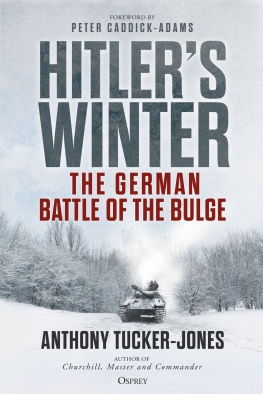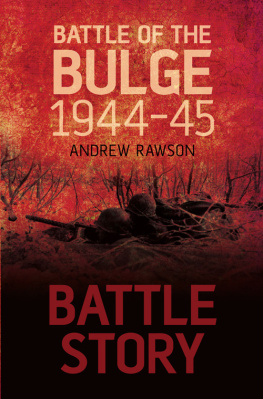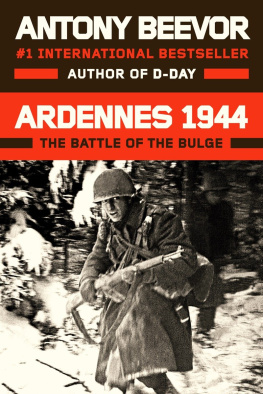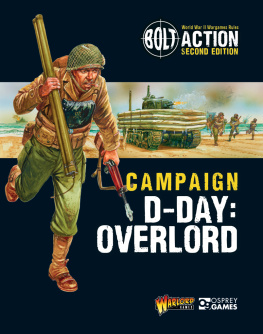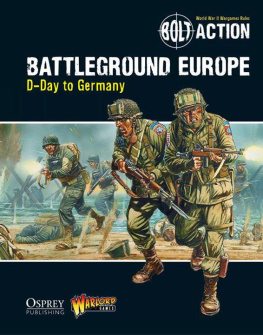
First published in Great Britain in 2017 by Osprey Games (part of Osprey Publishing),
2017 Osprey Publishing Ltd. and Warlord Games
Osprey Publishing
PO Box 883, Oxford, OX1 9PL, UK
1385 Broadway, 5th Floor, New York, NY 10018, USA
E-mail:
This electronic edition published in 2017 by Bloomsbury Publishing Plc
Osprey Publishing, part of Bloomsbury Publishing Plc
Warlord Games
T13/T15 Technology Wing, The Howitt Building, Lenton Business Centre, Lenton Boulevard, Nottingham, NG7 2BD, UK
E-mail:
All rights reserved
You may not copy, distribute, transmit, reproduce or otherwise make available this publication (or any part of it) in any form, or by any means (including without limitation electronic, digital, optical, mechanical, photocopying, printing, recording or otherwise), without the prior written permission of the publisher. Any person who does any unauthorised act in relation to this publication may be liable to criminal prosecution and civil claims for damages.
A CIP catalogue record for this book is available from the British Library
ISBN: 978-1-4728-1783-9 (PB)
ISBN: 978-1-4728-1784-6 (ePDF)
ISBN: 978-1-4728-1785-3 (eBook)
www.ospreygames.co.uk
For more information on Bolt Action and other products, please visit www.warlordgames.com
To find out more about our authors and books visit www.ospreypublishing.com. Here you will find our full range of publications, as well as exclusive online content, details of forthcoming events and the option to sign up for our newsletters. You can also sign up for Osprey membership, which entitles you to a discount on purchases made through the Osprey site and access to our extensive online image archive.
Contents

T his book is an expansion to Bolt Action, the 28mm scale tabletop wargame set during World War II. Whilst there is historical detail within the narrative, this volume is not a history book it is first and foremost a wargaming supplement. The team who put this book together took feedback from reviews of previous supplements and opinions from the Bolt Action community (www.warlordgames.com/forum). With this information to hand, the intention was to provide a good mixture of scenarios, new units and new rules whilst still giving some historical background for context. Some previously published rules and units have also been included this is to save players the expense of buying additional books for content which is vital to this volume, but might form only a small part of other books.
The Ardennes Offensive of December 1944, the battles that led up to it and continued from it are one of the most complex series of engagements in the European Theatre of Operations. Many excellent historical books have already been written which delve deep into the detail of this fascinating campaign given the focus of this book, it has only been possible to provide a superficial, broad brush overview of the campaign. For any readers who are interested in focusing more on the actual history of the battles, a of recommended texts has been provided.
CAMPAIGN OVERVIEW
Despite a spirited defence from the opening hours of the Normandy invasion in June 1944, Hitlers forces in northern France were comprehensively defeated and forced to retreat westward. Although their position was strengthened considerably following Operation Dragoon the landing in southern France in August 1944 the Allies were faced with considerable logistical problems as they advanced towards Germany, spreading their lines of communications and support thinner with every mile. Operation Market Garden, the massive airborne assault of September 1944, failed to meet its objectives and the momentum of the Allied advance was further threatened.
German forces were able to capitalise on this and with mounting pressure from the east as Soviet forces prepared for a winter offensive, Hitler decided to launch one last gamble a massive counter offensive against the Allies in December 1944. The 45-division German assault launched against American defenders dug in across the Ardennes region led to the largest single battle fought by the US Army in the twentieth century. The stakes could not have been higher for either side for Germany it truly was a last attempt to avoid being completely overwhelmed by the Western Allies, whilst for the American forces bearing the brunt of the assault, there was a very real threat that a German breakthrough could have undone all of the successes since D-Day. Codenamed Operation Watch on the Rhine by German forces, the initial successes of the campaign led to a worrying and distinctive bulge in the Allied front line, leading to the Allied press giving the offensive an immortal moniker: The Battle of the Bulge.

When the combined might of the Western Allies smashed into the beaches of Normandy on 6 June 1944, the last great offensive of the war in Western Europe was initiated. Over 150,000 troops from the United States, Britain, Canada and France to name but a few of the Allied nations would cross the English Channel on D-Day; by the end of August this number had risen to over 3,000,000.
German resistance was exceptional. American forces moved inland from Utah and Omaha beaches but encountered spirited opposition throughout the Cotentin Peninsula, with Cherbourg remaining in German hands until the end of June. Meanwhile, further to the east, British and Canadian forces encountered similar problems at Caen, where the historic city became the site of a two month bloodbath, but did succeed at least in diverting a significant proportion of German reinforcements from the east which otherwise would have broken through to engage US forces. By 25 August, American and Free French forces had linked up with French resistance fighters to liberate Paris.
A German column finds out that Belgian resistance is not futile.

In early to mid-August, the 1st US Army, 2nd British Army and 1st Canadian Army converged around FalaisChamboise to envelop some 50,000 men of German Army Group B. The ensuing Battle of the Falaise Pocket would effectively mark the end of the Battle of Normandy, and by the end of August German forces were in full retreat eastwards across the River Seine.
For Germany, a new defensive strategy was required. Soviet forces continued their advance in the east, squeezing Germany and her territorial gains between the two major advances. However, stretching nearly 400 miles along Germanys western borders was the Westwall, a series of defensive emplacements known as the Siegfried Line to the Western Allies. If German forces in the west could delay the Allied advance for long enough to prepare the Westwall and then retreat to the comparative safety of these fortifications, maybe the Allied advance could be stalled for long enough to prepare a counter attack which could reverse the tide of the war in the West.
SCENARIO 1: RETREAT THROUGH THE MONS POCKET








